Thrice and Slice
Third Leg from Santa Maria to Cabo San Lucas
We had a rough start getting out of the anchorage at Bahia Santa Maria. All of us were preparing the boat for passage. I focused on doing the dishes and putting everything away on the inside while Peter, Lynn and Sue prepared the outside—setting the jack lines1, taking the sail cover off, and getting the anchor ready. I heard the anchor chain moving and assumed Peter was already pulling up the anchor. Lynn was up with him and Sue was near the dodger.
I ran up to the helm to turn on the engine and begin the process of steering the boat. I felt stressed as I was still taking care of things down below and wasn’t yet ready. It turned out that Peter was only pulling up a few feet of chain to untie the bridle. He wasn’t ready to pull up anchor but then assumed I was ready when I turned on the engine. We both felt rushed by the other! There is a natural stress to starting a new passage which contributes to the possibility of misunderstanding. It calls for more awareness and communication.
The wind was blowing close to 20 knots inside the anchorage. High winds create stress in general, and when putting down or pulling up the anchor it can be challenging for the one at the helm. At least, it can be for me, because the wind can blow the boat off close to other boats or rocks due to the anchor no longer being set and the power of the engine not yet moving the boat forward.
We assumed that these winds were going to prevail, so I wanted to reef the main2 which takes time. When we finally got outside the anchorage the waves were 6 to 8 feet and the wind had significantly decreased. The reason it was blowing so hard at the anchorage was because of it’s acceleration through tunnels between the mountains. We were one of the last boats to leave the anchorage so we wanted to catch up.
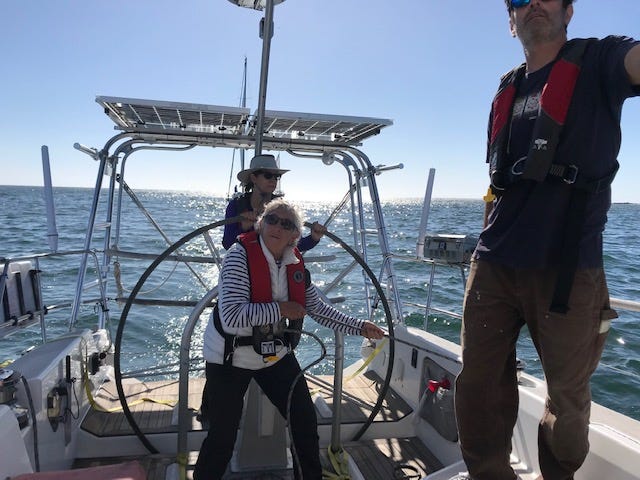
Downwind sailing can be really tricky when there is less wind and the waves are still higher. The roll of the boat can swing the boom, which ends up banging when the wind and waves work together to push the boom back against the mainsheet3. This banging is loud and sounds much worse than it is. When it’s bad, it can happen on nearly every roll of the boat. We finally decided to try sailing with jib alone and this seemed to work out well for a while. Luckily our boat moves pretty fast anyway.
We sailed with our jib alone for the rest of the day and into the night until the wind died. We weren’t as far off shore this time, so we didn’t get the sustained winds that we did on our other passages. We had to turn on our motor again at about four or five in the morning, so we could keep moving forward to reach our target of arriving in Cabo during the day light.
After motoring for a while, we got concerned about the amount of diesel we were using4. We did the calculations and we weren’t sure if we would have enough to motor all the way to Cabo. We decided to put up the Spinnaker for a third time since we left San Diego. The winds were light - about three to five knots. As soon as the Spinnaker was up and stable, we turned the motor off. The sound of the water and the boat gracefully gliding through it, was so soothing and peaceful. We didn’t care any longer about how long it would take us to get to Cabo. We were enjoying the present moment.
From the moment we launched the spinnaker, the wind started to build. After a while, we were sailing downwind fast enough that the wind on the boat felt like we were sailing upwind! We finally reached a point that our boat started to heel more sharply and the memory of our previous broach flooded my mind. The wind was coming up to 12 knots. We all agreed to take the spinnaker down.
Peter put me on the winch to manage the tack line5 while he went up to the bow to work the sock which gathers the sail. He was giving orders from the bow. Lynn and Sue were in the cockpit with me. Lynn noticed that I was holding the end of the tack line, wrapped around my hand. She exclaimed “No, never do that! Use the winch!” Later she shared how having the line wrapped around my hand could crush it if the wind picked up. I was so glad she was watching!
I was using the winch but the tack line was wrapped on top of the mainsheet, which was still wrapped around the winch. This was a trick that Norman taught us to do. Peter kept telling me to slow down the ease of the tack line but I was having trouble with it. I was doing my best but because it was on top of the mainsheet, the winch wasn’t holding it tightly enough. Eventually I had to release the line, and it flew out and up into the air leaving a rope burn in my hand. Fortunately, Peter was able to get the sock down to furl the sail so it didn’t fall into the water.
While Peter gathered the sail into the bag, he told me to turn the engine on and put it in forward while he finished up at the bow. As soon as I did that, we heard a gut wrenching noise underneath our boat. It was the forgotten tack line getting wrapped around our propeller. Peter yelled out “neutral!” We drifted for a while. I looked out the back and could see the end of the tack line floating about a foot under the waterline behind us. The noise we heard? The propeller actually slicing our tack line!
That was much better than it staying together and tangled around our propellor. Sue said, “I can get the tack line with a boat hook. I retrieve golf balls from the water all the time!” When she knelt down she was hanging off the back of the boat so she could reach deep into the water with the boat hook to grab the line. It was caught around our rudder. Peter took the line that was not in the water, and managed to release it from the rudder, then Sue was able to grab it out of the water. Hooray! What great teamwork! We lost our tack line and our mainsheet was damaged from the friction, but that was the extent of it. We will need to replace these lines but at least we were safe and able to move forward again.
The rest of the trip was uneventful. We pulled out our jib and sailed for a while. We did some calculations and realized we actually had enough diesel to motor again. We still were able to get to Cabo in daylight.
Of course, when we finally got fuel in Cabo, and calculated our remaining fuel, we realized we had enough fuel the whole time!
A big thank you to Lynn and Sue for all of their amazing help! Lynn is a great sailor and teacher. It was especially great that she understood my anxiety and gently encouraged me to expose myself to my fears. That it’s way more scary in my head than in actual reality if I would just take the risk. Given Lynn’s experience sailing and being a therapist, I finally let that in. Sue was also a very positive influence on me. She inspired me to paint with water colors. Peter got me water color pencils as a birthday present. It’s been on my bucket list for a while now. I especially appreciated how both of them knew how to relax and enjoy the ride.
The passage from San Diego to Cabo is officially over. The experience has taught me a lot about myself and how I approach life. Isn’t life uncertain a lot of the time? I didn’t have to face that reality as much as I am having to now. Sailing on the open ocean is like life on steroids because of the risks. The risks force me to have to think about what I need and how to express my needs as consciously and clearly as possible versus reacting. I’m trying not to let my fears take over and overwhelm me. It’s not easy but I’m appreciating the challenge—learning to trust how life unfolds in a way that seems to work out. We are still alive!
I am enjoying the rewards of living on the water, surrounded by nature and it’s exquisite beauty. There is more to come. We hope you stay tuned!
Like what you’re reading? Let us know!
We really enjoy reading your comments, and seeing your likes! It lets us know you’re there, and gives us a sense of connection to our family and friends. We also appreciate your feedback. Take a minute to leave a comment, or just hit the like button!
Jack lines are strung across the deck from bow to stern (front to back), along the side decks. When at sea, each crew member wears a life jacket with a harness, and a tether that connects the harness to the jack lines. This is intended to prevent anyone from falling overboard.
Reefing is done to reduce the area of a sail. In other words, the sail is made smaller, and therefore less powerful. The sails are reefed to prevent the boat from being overpowered as the wind speed increases.
The mainsheet is the line (made of rope) that is used to trim the mainsail. Essentially, it prevents the boom from being pushed too far out by the wind. The process of adjusting it according to the strength and direction of the wind is called trimming.
There are two different fuel gauges on the boat, and of course they were both giving us different readings. Peter did the math to figure out how much fuel would be left after so many hours with the consumption figures he calculated from previous fill-ups. Those consumption figures were a range though, so the calculations weren’t definitive.
The tack line is tied into the tack (lower, windward corner) of the sail and leads to one side or the other of the bowsprit and down through a block and then back along the deck into the cockpit.





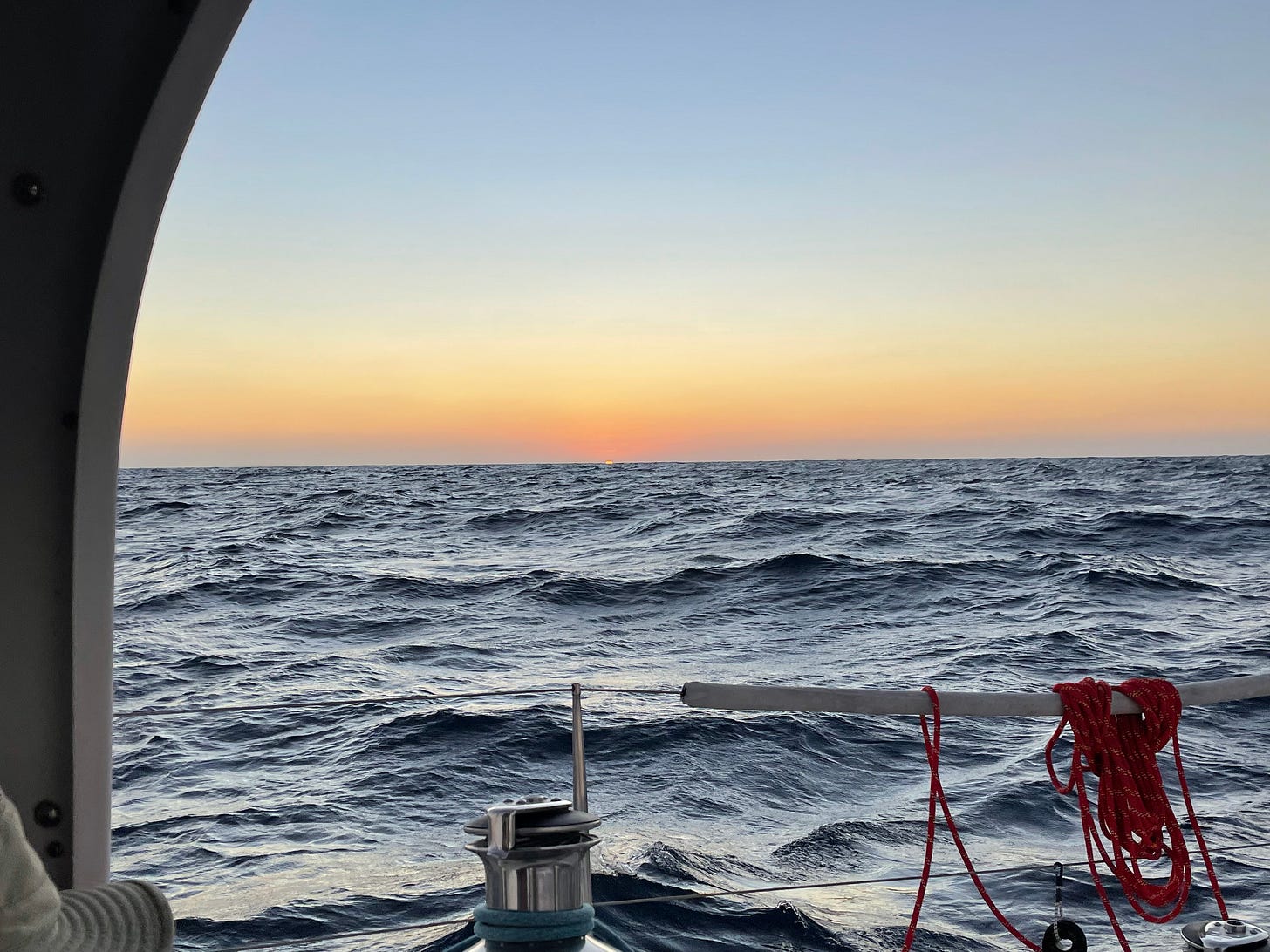




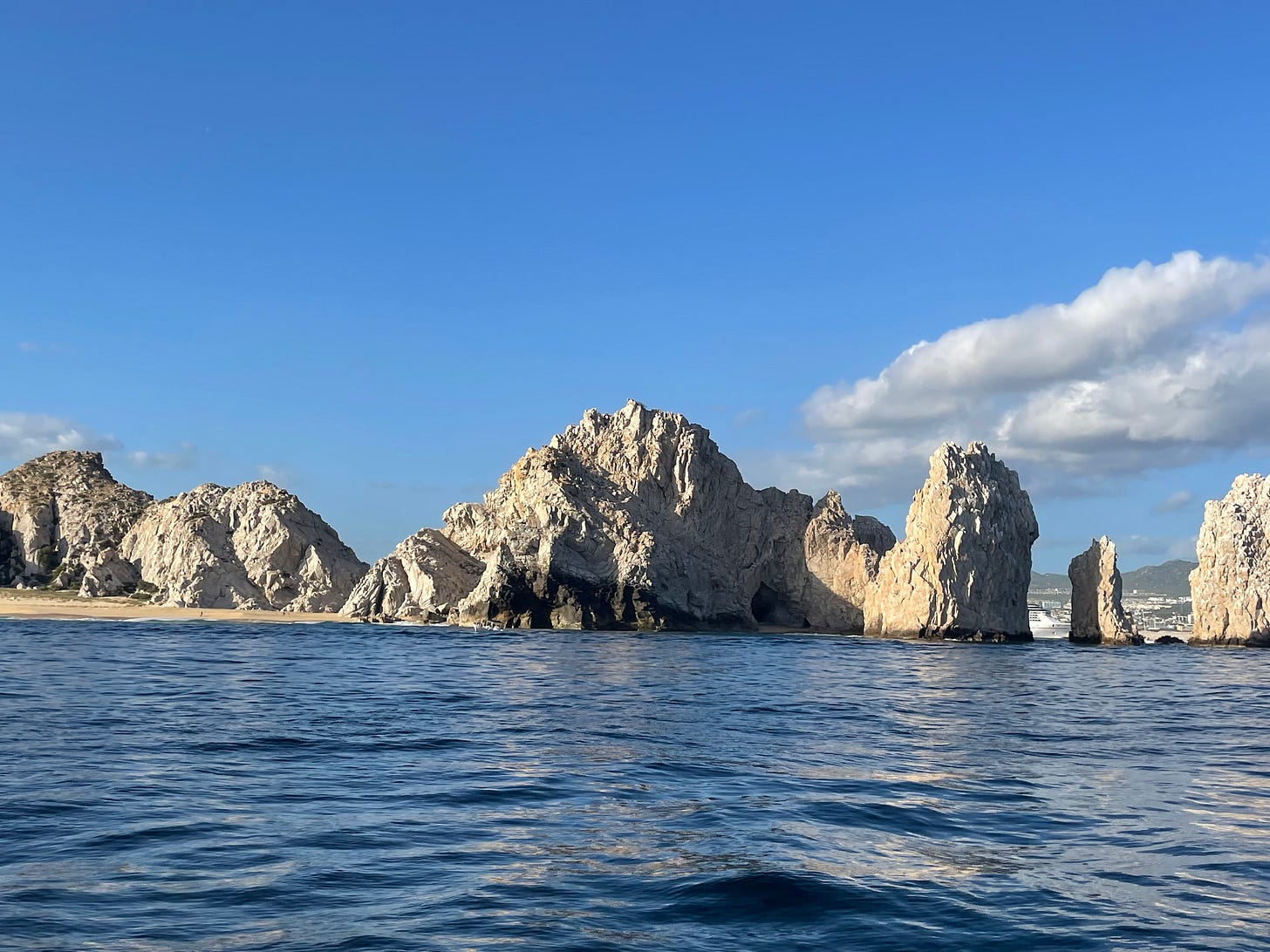



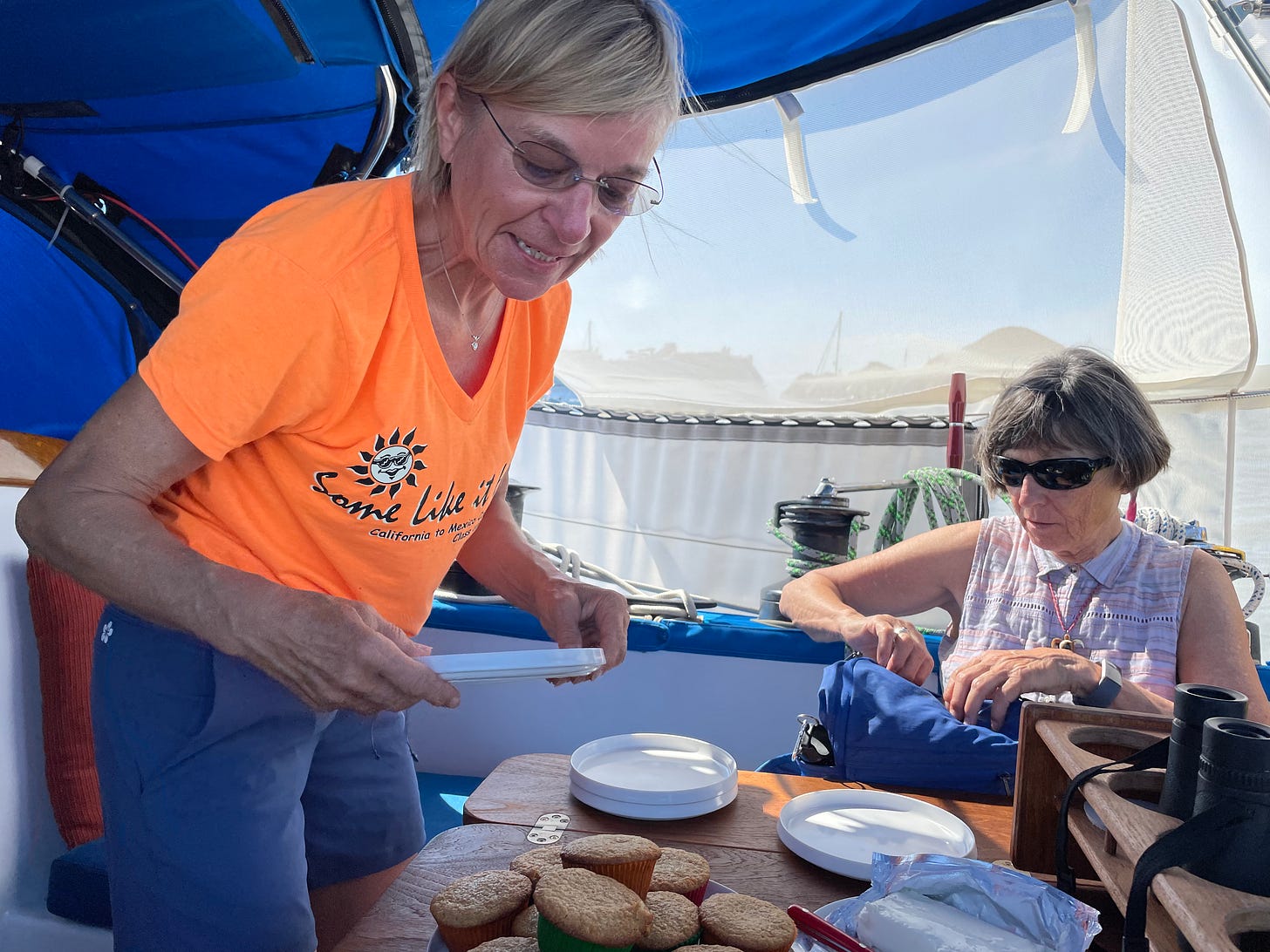




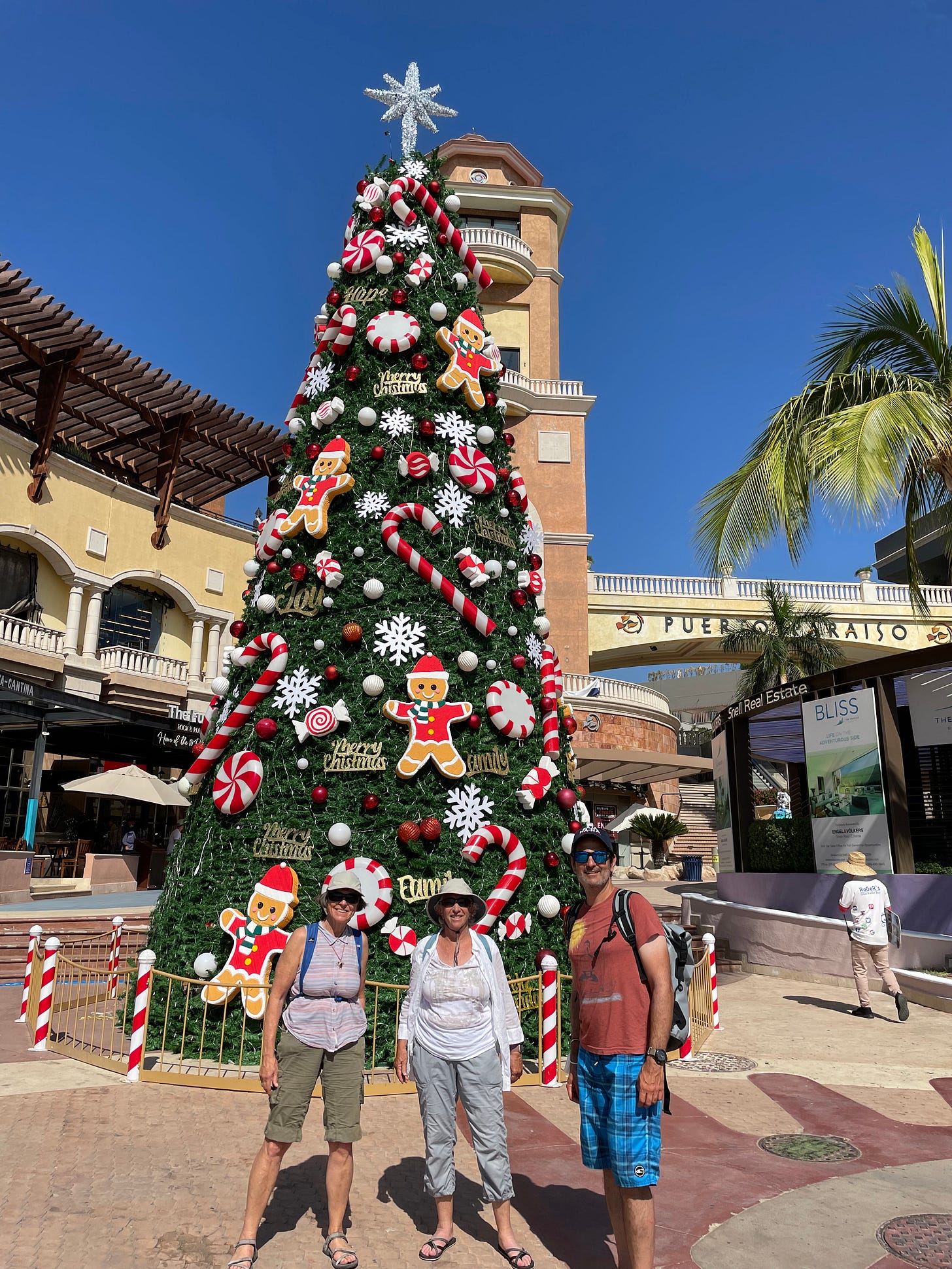


What a wonderful, wooly, wet, and wild ride you guys! Way to go, Donna facing the ocean, facing your fears and leaning in to trusting others, your self, and of course, Salacia! Looks like an epic journey. Sending much love from SF- wet here too! Water from above, not below. Take care.
I hear Loreto's a good place to go... and Playa Coyote